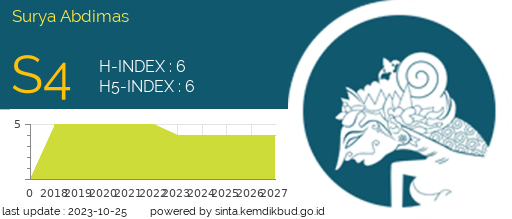Motivation and Development of Cosmetology Skills for Female Prisoners of Class II B Bengkulu Detention Center by Utilizing Domestic Production Technology
Abstract
Criminals or convicts placed in detention centers or prisons with the provisions of the law actually aim to provide a deterrent effect and provide religious understanding so that after the detention period is over they can behave better and not make the same mistakes. However, many of them, after leaving detention, no longer have the trust of the local community where they come from, so that it is difficult for these ex-convicts to get jobs and do not have the skills to become entrepreneurs. This is what makes ex-convicts lose confidence and even repeat the same mistakes. The method of delivering learning material uses a participatory learning approach by providing material and implementing practices. The implementation of this community service activity was carried out at the Bengkulu IIB Prison which was attended by 30 convicts. The Community Service Implementation Team has provided motivation and tips for success for prisoners, conducted cosmetology and beauty training based on the use of domestic production technology, and introduced other alternatives for sources of income such as the manufacture and marketing of organic masks intended for women. convicts as provisions in improving their health. skills at the Class IIB Correctional Institution of the Bengkulu Ministry of Law and Human Rights. Therefore, the service team hopes that from this service the prisoners will gain alternative skills in welcoming the prisoner's free period later.
Downloads
References
Aswanto. (1999). Jaminan Perlindungan HAM dalam KUHAP dan Bantuan Hukum Terhadap Penegakan HAM di Indonesia, Disertasi, Makassar: Perpustakaan FH-Unair.
Darmadi, H. (2018). Educational management based on local wisdom (descriptive analytical studies of culture of local wisdom in west kalimantan). Journal of Education, Teaching and Learning, 3(1), 135-145.
Erlinawati, W. S., & Dwiyanti, S. (2018). Pengaruh Proporsi Tepung Beras dan Bubuk Kunyit Putih (Curcuma zedoaria Rosc.) Terhadap Hasil Lulur Bubuk Tradisional. Jurnal Tata Rias, 7(3), 15-22.
Faria-Silva, C., Ascenso, A., Costa, A.M., Marto, J., Carvalheiro, M., Ribeiro, H.M., Simoes, S. (2020). Feeding the Skin: A New Trend in Food and Cosmetics Convergence. Trends in Food Sci. & tech. 95: 21-32
Fountain. (2011). Cokelat nikmat bermanfaat. http://fountainchocolate.com. Diakses tanggal 29 Mei 2023.
Khalil, Munawar. (2016). Raja Obat Alami Beras. Yogyakarta.
Kustanti, Herni. (2008). Tata Kecantikkan Kulit Untuk SMK Jilid 1. Jakarta: Direktorat Pembinaan Sekolah Menengah Kejuruan.
Mentari, T. A. S. (2018). Penggunaan Media Pembelajaran Multimedia Interaktif Untuk Meningkatkan Aktivitas Dan Hasil Belajar Mahasiswa Pada Mata Kuliah Rias Wajah Karakter Foto/TV/Film Program Studi Pendidikan Tata Rias dan Kecantikan Jurusan Tata Rias dan Kecantikan FPP UNP. UNES Journal of Education Scienties, 2(2), 194-199.
Na’imah, J. (2018). Optimasi Masker Beras untuk Wajah. Jurnal Ilmu Kesehatan. 4(1): 2-6.
Puspitorini, A. (2020). Teknik Mixing Foundation Tata Rias Wajah Cikatri Untuk Kelainan Kulit Vitiligo Pada Pengantin Modern. Jurnal Tata Rias, 9(1).
Istira Rahmahani, A. (2020). Penerapan Tata Rias dan Busana sebagai Pendukung Status Sosial Karakter Utama dalam Film Fiksi “Rahim Puan” (Doctoral dissertation, ISI Yogyakarta).
Suranny L. E., dan Wagino. (2019). Pengembangan Potensi Kopi Ndorog Wonogiri Menjadi Komoditas Unggulan yang Berkelanjutan. Jurnal INISIASI 8(2): 77-84.
Tilaar, Martha. (1995). Indonesia Bersolek : Tata Rias Korektif : Buku Pedoman Seni Rias Indonesia. Jakarta: Grasindo
Valwinda, D., Yanita, M., (2019). The Effect Of Mixing Foundation Towardsresults OfWest Sumatera Bracelet Face On Oil Face Skin. Jurnal Pendidikan dan Keluarga. 11 (02).
Wulandari, A., Rustiani E., Noorlaela E., dan Agustina, P. 2019. Formulasi Ekstraksi dan Biji Kopi Robusta dalam Sediaan Masker Gel Peel Off untuk Meningkatkan Kelembapan dan Kehalusan Kulit. Fitofarmaka Jurnal Ilmiah Farmasi. 9(2): 77-85.

Copyright (c) 2023 Pamela Mikaresti, Yusrizal Yusrizal, Ana Nurmalia

This work is licensed under a Creative Commons Attribution-NonCommercial 4.0 International License.



